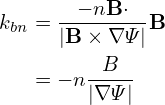

 d𝜃.
d𝜃.The generalized toroidal angle α is numerically calculated in my code. To verify B ⋅∇α = 0 along a magnetic field-line, figure 26 plots the values of α along a magnetic field line, which indicates that α is constant. This indicates the numerical implementation of the field-aligned coordinates is correct.


 d𝜃.
d𝜃.
Let us introduce the binormal wavenumber, which is frequently used in presenting turbulence simulation results. Define the binormal direction s by
s =  , ,
|
which is a unit vector lying on a magnetic surface and perpendicular to B. The binormal wavenumber of a mode is defined by
 | (339) |
where p is the phase of the mode. Consider a mode given by exp(ikψψ + im𝜃 − inζ), then the phase p = kψψ + m𝜃 − nζ. Then kbn is written as

![nB ⋅
kbn = |B-×∇-Ψ|[q∇Ψ × ∇𝜃 − ∇Ψ × ∇ ζ].](tokamak_equilibrium438x.png) | (342) |
Using Eq. (262), i.e., B = −(∇ζ ×∇Ψ + q∇Ψ ×∇𝜃), the above expression is written as

 | (343) |
which indicates the binormal wavenumber generally depends on the poloidal angle. For large aspect-ratio tokamak, we have Bϕ ≈ B, q ≈ Bϕr∕(BpR). Then Eq. (343) is written
 | (344) |
which indicates the binormal wavenumber are approximately independent of the poloidal angle. Since m = nq on a resonant surface, the above equation is written |kbn|≈ m∕r, which is the usual poloidal wave number. Due to this relation, the binormal wavenumber kbn is often called the poloidal wavenumber and denoted by k𝜃 in papers on tokamak turbulence. In the GENE code, y coordinate is defined by y = αr0∕q0. Then the ky of a mode of toroidal mode number n is given by ky = 2π∕λy where λy = λαr0∕q0 and λα = 2π∕n. Then ky is written as ky = nq0∕r0, which is similar to the binormal defined above. For this reason, ky of GENE code is also called binormal wave-vector, which is in fact not reasonable because neither ∂r∕∂y or ∇y is along the binormal direction.